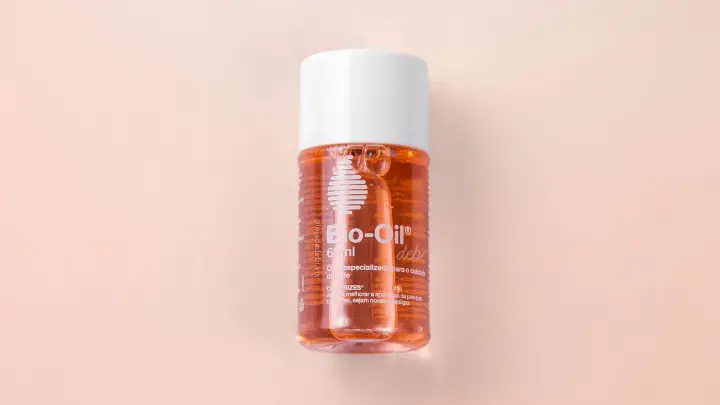As it is, two of the best and most effective ingredients in skincare are niacinamide and retinol.
Although best known for their ability to help rejuvenate aging skin, these two are also part of the most researched anti-acne ingredients in history.
However, there is a lot of confusion regarding their exact mechanism of action and whether they should be used together or not. Today I want to clear up the confusion.
Let’s take an in-depth look at these helpful ingredients and see how they can benefit your skin health.
What Is Niacinamide?
Niacinamide is a form of vitamin B3, which is also known as nicotinic acid. You can find it in supplements, skincare products, and foods such as fish, meat, and whole grains.
Niacinamide is an essential nutrient that helps maintain healthy-looking skin by promoting cellular turnover, improving elasticity, and providing antioxidant protection from environmental stressors like UV rays.
It also reduces melanin production (which can contribute to uneven pigmentation) and improves the appearance of sun damage and scars by promoting collagen synthesis.
Because of these benefits, manufacturers often add niacinamide to skincare products such as cleansers, toners, moisturizers, and serums to help fade fine lines, reduce wrinkles, and brighten the skin.
What Are the Benefits of Using Niacinamide?
Anti-aging
Niacinamide helps to increase the elasticity of the skin by increasing collagen production and improving cell turnover. As a result, it makes your skin appear younger and smoother, which helps to minimize the appearance of wrinkles and other signs of aging.
Treats acne
Niacinamide reduces the production of sebum, which leads to acne breakouts. It’s also effective in treating acne scars by lightening them up or fading them away.
If you have acne or are prone to acne breakouts, then niacinamide is a perfect addition to your skincare routine.
Increases hydration
Niacinamide increases skin hydration because of its ability to improve skin barrier function by stimulating ceramide production. You can also use this ingredient to get rid of dry skin since it will help prevent water loss and keep your skin healthy.
Reduces Hyperpigmentation
Hyperpigmentation is a condition where the skin becomes darker than its natural tone. This can occur as a result of hormonal changes, sun damage, or prolonged exposure to the sun.
Because niacinamide increases cell turnover and reduces melanin production, it is an effective treatment that can help reduce hyperpigmentation.
What Is Retinol?
Retinol is a vitamin A derivative that helps with skin regeneration and also reduces the appearance of fine lines and wrinkles.
It is known as an “anti-aging” ingredient because it helps to remove the outer layer of dead skin cells while stimulating the production of new skin cells beneath the surface.
By removing dead skin cells and producing new ones, your overall skin becomes smoother and healthier looking. Retinol also increases the rate at which the body produces collagen (a protein that helps the skin stay firm and supple).
Thanks to its anti-aging properties, you can find it in body washes, serums, and creams formulated for people who are looking for a more youthful appearance.
Retinol works best when combined with other ingredients that help it penetrate the skin, such as hyaluronic acid. If you’re new to retinol skincare products, start slowly and use them every other day until your skin gets used to them.
What Are the Benefits of Using Retinol?
Fades dark spots
Retinol works by speeding up cell turnover. As a result, it helps smooth out dark spots on your skin, such as sunspots and age spots. In addition, retinol significantly improves skin appearance by brightening overall skin tone.
Treats acne
Retinol can improve acne and acne scarring because it penetrates deep into the skin to reduce oiliness and unclog pores. Retinol works on all skin types and retinol products are available at many different price points.
Increases collagen production
Retinol increases collagen production in the inner layers of the skin, which helps to strengthen and tighten the skin. It also helps increase elasticity in aging or thinning skin, which results in a more youthful appearance.
Increases hydration
Retinol helps your skin retain its moisture level by penetrating deep into the dermis layer where it stimulates collagen production.
As your collagen levels increase, so does your skin’s barrier function. The result? A reduction in water loss while also strengthening your overall skin barrier.
Reduces fine lines and wrinkles
By stimulating collagen production, retinol helps reduce the appearance of premature signs of aging such as fine lines and wrinkles. This is why you can find it in a wide range of anti-aging lotions, gels, solutions, and creams.
Is It Safe to Use Niacinamide and Retinol Together?
The short answer is yes. You can use both ingredients to address various skin issues including fine lines, wrinkles, hyperpigmentation, acne, oiliness, and other aging signs.
Niacinamide and retinol belong to different chemical families but they have several properties in common. Both ingredients are very effective at improving skin texture, evening skin tone, and treating skin conditions like acne, and rosacea.
Retinol is well-known for its ability to help improve skin tone and texture by encouraging the production of healthy new skin cells, while niacinamide has become a popular choice in recent years as a gentler alternative to retinol.
However, experts recommend that you don’t use the two ingredients at the same time of day, especially if you have sensitive skin. They both increase skin sensitivity, and if you put them on at the same time, it could result in unwanted side effects.
It is best to use niacinamide during the day and retinol at night, as retinol is very sensitive to sunlight. Also, ensure to use sunscreen during the day to enhance the benefits of niacinamide on your skin.
Benefits of Using Niacinamide and Retinol Together
They have complementary functions
Niacinamide is a precursor to nicotinamide adenine dinucleotide (NAD+), which plays an important role in the production of collagen by fibroblasts. Retinol increases fibroblast proliferation. Together, they produce greater, longer-lasting results.
They lighten hyperpigmentation
Niacinamide lightens hyperpigmentation by inhibiting melanin transfer from melanocytes to keratinocytes, which are cells that make up the outermost layer of the skin. Retinol increases cell turnover and speeds up exfoliation, thereby brightening and evening out overall skin tone.
They can minimize pore size
Retinol makes pores look smaller by causing them to contract while niacinamide works to strengthen the walls of your pores so they don’t get clogged with excess oil or dirt.
They treat mild to moderate acne
Niacinamide and retinol are also both effective for treating acne. Since these two ingredients can help to unclog pores, and reduce inflammation, redness, swelling, and irritation caused by pimples.
They can improve your complexion
The exfoliating properties of retinol combined with the skin-repairing properties of niacinamide can make your complexion appear smoother, clearer, and younger-looking. These ingredients will reduce redness, blemishes, and other signs of aging on your face.
Can You Use Niacinamide and Retinol Together to Treat Acne?
Yes, you can. Niacinamide and retinol work very well together in treating acne and making the skin look smoother, plumper, and firmer.
Niacinamide works by fighting inflammation, which can help reduce redness and swelling in your skin. Retinol helps to unclog pores and stop the growth of bacteria which can lead to more breakouts.
The combination of these two ingredients is a powerful tool in your anti-acne skincare regime. Niacinamide also stimulates the production of ceramides, which are important components of healthy skin cells’ outer membranes.
For stubborn acne, use niacinamide with benzoyl peroxide. Benzoyl peroxide is a known pore-cleanser, but it can be drying and irritating to sensitive skin. By combining it with niacinamide, you can avoid irritation while still getting rid of acne-causing bacteria.
Can You Use Niacinamide and Retinol Together to Treat Aging Skin?
Absolutely. These two ingredients have been proven time and time again to be capable of reversing the signs of aging, even in many cases where other ingredients have failed.
Niacinamide is a form of vitamin B3 that helps prevent further damage to the skin by protecting it from sun rays, toxins, and smoke. It also helps increase skin firmness and elasticity due to its collagen-boosting properties.
Retinol, on the other hand, is a form of vitamin A that helps increase collagen production, making your skin look younger. As a natural exfoliator, it also helps remove dead cells for brighter, healthier-looking skin.
When you apply these two ingredients topically, they help reduce the appearance of wrinkles, fine lines, and other aging signs. This improves your skin look, looking supple and youthful.
So Which Is Better- Niacinamide or Retinol?
The best way to decide which one is best for your skin is to consult a dermatologist. They will help you choose the one that suits your skin type and concerns you the most.
Niacinamide is less irritating than retinol, so it’s a good choice for those with sensitive skin. Retinol can penetrate deeper into the layers of the skin, so its effects are more visible than that of niacinamide.
While niacinamide can be used in all skin types, retinol may be too irritating for sensitive skin. Therefore, if you have sensitive skin, your dermatologist may recommend niacinamide instead.
Both niacinamide and retinol are available in prescription or over-the-counter formulations. Prescription forms tend to be more concentrated than OTC products and carry a higher risk of side effects such as redness or irritation.
FAQs
Is niacinamide safe for sensitive skin?
Yes, it is. If you have sensitive skin, you can use niacinamide on it. However, if you are allergic to niacin or other forms of vitamin B3, you should avoid niacinamide as well, since they are similar ingredients.
If you’re new to niacinamide and aren’t sure how your skin will react to this ingredient, try one of the gentler niacinamide products (cleansers and moisturizers) available before switching to a concentrated product (prescription creams and serums).
What should you not use with retinol?
Glycolytic acid, salicylic acid, lactic acid, and any other harsh chemical exfoliant. These products are highly acidic, and combining them with retinol can irritate your skin.
If you have sensitive skin, you should also avoid products that contain vitamin C or benzoyl peroxide. Both of these ingredients can cause side effects like redness, itching, and dryness if you use them with retinol.
Can you use retinol and hyaluronic acid together?
Yes, you can. Retinol and hyaluronic acid are two popular anti-aging ingredients that can help reduce the signs of aging. They do not work in the same way, so you can use them together without any problem.
However, you have to do a patch test before using both retinol and hyaluronic acid in your skincare routine. Moreover, retinol increases the risk of sun sensitivity, so you should always wear sunscreen when using this ingredient.
Conclusion
Niacinamide and retinol are two skincare ingredients that have been proven to help repair sun damage, improve uneven skin tone and reduce the appearance of wrinkles.
You can find both ingredients in a variety of prescription and over-the-counter products, including moisturizers, serums, and creams.
You can also use them together to improve your skin tone, texture, and appearance. The only downside to this is that they can cause mild irritation in some people.
To avoid any negative side effects, start off with small amounts every two days until your skin gets used to it. Then you can increase it to daily usage.
Thanks for reading.
Visit Serum101 if you’d like to learn more about these two ingredients and others like them.






